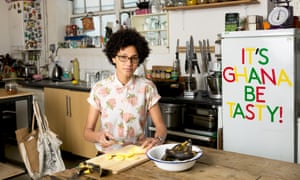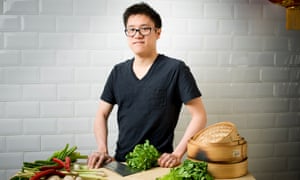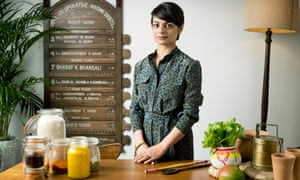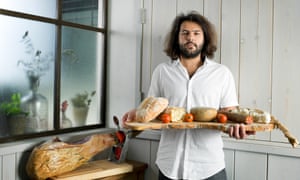Let’s eat together: how immigration made British food great
Let’s eat together: how immigration made British
food great
Immigrant communities have dramatically changed the food we eat. Nigel Slater celebrates the richness of our blended heritage. Plus, five young chefs reveal how their culture influences their cooking, and reveal a favourite recipe.

I can think of no place that welcomes the food of other countries with more enthusiasm than Britain. Good though our indigenous cooking is, made with ingredients from our own landscape, we have long had an insatiable appetite for the food of other countries. A walk along our high streets will offer everything from sashimi to tacos and pizza to Korean noodles. Some of this food comes from chain restaurants with global domination, but for the most part it is the product of small restaurants and food shops run by first- or second-generation immigrant families that have come to Britain and set up shop. It is something I wholeheartedly want to celebrate.
Walk past the big international retailers and you will pass a string of small restaurants, cafés and food shops. As the smell changes from cappuccino to cardamom, we enter the home of the kebab and the korma, the dim sum and the laksa, places where you can get your hands on a box of Alphonso mangoes or a warm, freshly baked roti. The further we go, the food becomes ever more intriguing, more tempting.
Now do the same in Nice or Naples, Stockholm or Bordeaux. There will be little food on offer that isn’t local. Certainly there will be sections of each city with a particular culinary flavour, but there won’t be anything like the concentrated array of nationalities there is in Britain. No one, it seems to me, has embraced the products of the rest of the world’s kitchens like the Brits.
It would be churlish and uninformed to assume that this enthusiasm is a product of our own food not being good enough to retain our interest. Those who peddle that old idea need to catch up. British food has never been more interesting. It is more that we are, mostly, a nation of adventurous eaters. Our appetites are open-minded, our plates ever happy to receive something new. We should not be considered gluttons who eat anything that comes our way, but rather culinary magpies who pick up the best on offer. To restrict ourselves to indigenous products, however good they are, would be to miss out on some fine eating, from the tea in our pots (camellia sinensis, the tea bush, doesn’t survive well in this climate) to the food of Chinese, Indian and Italian kitchens.
Our eagerness for the cooking of other countries is not confined to restaurants either. At home in the past week I have eaten the products of about six different countries. Italian gnocchi with gorgonzola on Monday, Thai pork ribs on Tuesday, Japanese sushi on Friday. (On Thursday my planned dinner of Taiwanese buns was nipped in the bud only by the length of the queue I was expected to join. We ate decent jamón at a Spanish bar instead.) It was on Sunday that I ate what you could call a British meal: asparagus from the Wye Valley, roast chicken from Suffolk and roast potatoes grown in Herefordshire. If I was someone who eats processed chilled foods from the supermarket, a business worth billions of pounds in this country, I would probably have eaten even more adventurously.
Our own home cooking of a Thai or Indian recipe may not be authentic, but that only proves our willingness to adapt the ideas of others where it suits us. A fact that may horrify those who demand “authenticity” but suits most of us non-pedants who just want something good to eat. As any cook knows, authenticity varies according to who you ask – every Italian has a different way of making a carbonara, just as every British cook’s recipe for Yorkshire pudding or apple pie varies.
I am not interested in cooking in a kitchen that doesn’t include ingredients from other countries. Imagine a lifetime trying to make good things to eat without access to lemons or cardamom, vanilla or limes. No cumin or Vietnamese chilli sauce. No cane sugar, chocolate or cinnamon. No oranges, tea or coffee either.
But let’s go back to that British high street. Just suppose we fancy a dumpling. And this is the great bit, and why I cannot understand why a small minority of people shun international food: we have so many to choose from. That dumpling could be a meat-filled ravioli from Italy, a crisp-bottomed Japanese gyoza, a Chinese soup-filled xiaolongbao or a soft and juicy Polish pierogi. They are all essentially the same thing, a precious, highly seasoned filling enclosed in a wrapper of dough. The recipe and method of making them varies delightfully from culture to culture (even city to city), but none is that far from the other. (Our own version is the other way round, the dough being cooked in the meat filling.) What seems at first so different is the same the world over. And it is all here on our doorstep. The same story goes for the noodle, the soup, the pie and sandwich.
I have spent the last year making a television series that explores how the cooking of our landscape has been enriched by non-native food. A celebration of the ingredients, recipes and dishes that have found their way to our shores, mostly with those who have moved to Britain from other countries. The series is about both the food and those who have brought it with them. Each contributor has a story to tell. This series brings very separate groups of people together round the table, cooking their food, telling their stories, but most importantly, tasting each other’s food. Food that unites us in more ways than one.
Zoe Adjonyoh, Ghana

How did you come to know the cooking associated with your heritage?
I’m Irish-Ghanaian and my father would come home with weird and
wonderful ingredients. I was inquisitive and would watch him cook.
How did you learn to cook?
I’d ask grocers on Ridley Road in London what to do with ingredients,
and I went back to Ghana on a recipe mission and to connect with family.
What’s your favourite Ghanaian ingredient? Scotch bonnet pepper, fresh ginger, tomatoes….
How do you feel mainstream Britain has adapted Ghanaian cuisine?
Considering how many people from West Africa live in the UK, its food
is massively underrepresented in the high street and in people’s living
rooms.
Is food an important part of a country’s cultural heritage? Yes – everybody eats, and a culture can grow up around how food is cooked or farmed.
Do you think it reflects our attitudes to immigration more generally?
Maybe the African community has historically been more isolated, but
now a huge number of second-generation kids want to show off their food
and culture.
What interests you most about British attitudes to food? Here in London people are very open and interested. There’s certainly an adventurous palate.
What is a the dish from your culinary heritage that Britain doesn’t get?
Okra soup is big in the Volta region of Ghana, which is tricky because
it’s quite slimy. I pan-fry it with tempura batter so it’s got some
crunch.
No kitchen is complete without… An asanka pot – a clay pestle and mortar. You can grind spices in it, cook with it on the fire and then eat out of it.
Zoe’s Ghana Kitchen (zoesghanakitchen.co.uk) will open at POP Brixton in London on 29 May
Jeremy Pang, China

How did you come to know the cooking associated with your heritage?
From a Chinese cultural point of view, we live our lives to eat. My
mother’s father opened the Ho’s Bakery in Manchester’s Chinatown in the
60s. My dad’s family, from Hong Kong, opened the Dragon restaurant in
Finsbury Park in the 70s. My uncle also had Pang’s Cottage in
Hillingdon. So it’s in my blood.
What does Chinese food mean to you?
It’s all about sharing. You never have one dish for one person –
everyone shares. If you know your Chinese food, you’re looking for
balance in flavour, texture and colour. In western restaurants
presentation is about making one plate look pretty. The Chinese way is
making the whole table of food look pretty.
How did you learn to cook?
My dad was a pharmacist, but my love of food comes from his passion for
cooking. I used to watch him and learn. My sisters and I had to guess
what ingredients had gone into our food every night, and that trained my
palate. That was before I even started to cook.
Is food an important part of a country’s cultural heritage?
It’s so important. I was brought up in British and Chinese cultures and
I see a huge love of food and pride in both. In the UK it’s about
making the best fish and chips or Yorkshire pud, and in China we have
our own favourite dishes, too.
Do you think of different cuisines as separate or can they be mixed?
Chinese and British food are totally mixed. The Brits were in Hong Kong
for a long time, so there’s influence both ways. Ketchup is used with
many British dishes, but sweet and sour sauce – a Cantonese standard –
is made with sugar, ketchup and vinegar. Inside dim sum buns you often
get spam as a filling. If you go for a greasy spoon breakfast in Hong
Kong, the best dish is macaroni in chicken soup with spam and a fried
egg on top.
What is your favourite Chinese ingredient? In Chinese I’m a “fan tung”, or “rice bin”. Every meal should come with rice on the side.
No kitchen is complete without… A
wok. You have to know how to use it. Understand the height of your
fire. Most British people use a wok as a casserole pan, but a stir-fry
should take no longer than 5 minutes.
Chinese Unchopped by Jeremy Pang (Quadrille, £20 or £16 from the Guardian Bookshop) is out next month. For details on Jeremy’s cookery school, go to schoolofwok.co.uk
Meera Sodha, India

How did you come to know the cooking associated with your heritage?
The kitchen the cornerstone of a Gujarati home. We were eating my
mother’s hot fragrant chapatis with different vegetable curries every
night.
What does Gujarati food mean to you? It’s a
way to look into the past and see where my parents came from. I know
what my mum cooked in poverty, when they could only buy lentils and make
dal. I know what my father ate in Uganda when he was dreaming about my
mother, and that was rajma, these silky kidney beans, and ugali – a
polenta mix.
How did you learn to cook? I was
rolling wonky chapatis ever since I could put my nose over the kitchen
counter, but it was only at university that I realised how awful the
canteen food was and how misrepresentative the Indian food in curry
houses was and how desperately I missed my mother’s cooking. I asked Mum
to send me recipes, but she’d never written anything down. I felt
panicked and went home to learn from watching her.
Do you think of different cuisines as separate or do you think they can be mixed?
I’m British and grew up in Lincolnshire and I’m using Jerusalem
artichokes and Swiss chard to make curries. Cuisines have to change and
evolve to remain current. It doesn’t mean that they’re not authentic.
What is your favourite ingredient?
Right now curry leaves. They do this magical thing: when the oil’s hot
you throw them in and they crackle. I love that sound and the smell they
give off, a citrusy smoke.
How do you feel about how mainstream Britain has adapted Indian cuisine?
There’s a place for all of it. What I’m doing is different – it’s not
meaty curries, it’s fresh and nutritious – but I don’t feel precious
about it. Britain and India have such an age-old love affair – Queen
Victoria was a massive curry fan and I’ve got a recipe book of old court
favourites I love!
Which restaurant in Britain best represents Gujarati cuisine?
There aren’t that many because Gujaratis aren’t restaurateurs and the
belief is that the best Indian food is in the home. But Bobby’s in
Leicester is one of my favourites.
No kitchen is complete without… An onion, Radio 4 and a very sharp knife.
Meera Sodha’s book Made in India is published by Fig Tree (£20, or £14 from the Guardian Bookshop)
Omar Allibhoy, Spain

How did you come to know the cooking associated with your heritage?
I grew up in Madrid, and I’ve cooked from the age of two. My mother was
an amazing baker, but she wasn’t the most adventurous in the kitchen,
so I did my own experiments. Mum used to call me the spice kid. Lots
were failures – I remember putting curry powder in spaghetti bolognese –
but that’s how I learned. My older brother was a brutal critic.
What does this food mean to you?
Tapas is central to the Spanish experience, the way we gather round
with friends and family to share it. The legend has it that King Alfonso
XX was sick and told by his doctor to drink wine to ease the pain, but
he asked for a little food with each glass so as to not get intoxicated.
How has mainstream Britain adapted Spanish cuisine?
It’s incredible. There are 12 million British visitors to Spain each
year – tapas restaurants offer a bit of Spain at home. About 50% of new
restaurants serve small plates now. Homes are getting smaller,
especially in London, so people socialise out more. It’s also getting
warmer – I’m convinced it’s at least two degrees warmer than it was when
I arrived 10 years ago.
Do you think that reflects our attitudes to immigration more generally?
The thing I admire most about the UK is how absorbent you are – you
grab everything that is good and make it your own, and you are very
adventurous with food. There’s a snowball effect, because there are so
many ethnic communities, the food has to be good and the next restaurant
better than the last.
Which dish best combines British tradition with your tradition?
We’re launching “bun-cadillos”: your usual lunchtime sandwich but with
Spanish bocadillo flavours – chorizo, manchego, deep-fried squid –
served in a brioche bun. An English, French, Spanish mix.
What’s your favourite Spanish ingredient?
Things like garlic or Spanish paprika, or of course jamón ibérico –
pigs that live freely in Spanish woodlands only eating acorns, then
cured with salt and air-dried for three years.
No kitchen is complete without… A little drizzle of olive oil.
What’s the restaurant that best reflects Spanish cuisine? Barrafina. They use very good ingredients, simply cooked.
Tapas Revolution Shoreditch (58 Bethnal Green Road, London E1; tapasrevolution.com) is open now
Yasmin Khan, Iran

How did you come to know the cooking associated with your heritage?
My grandparents were farmers, so we had this playground of fruit and
veg. After holidays we would relate to memories through food.
How did you learn to cook? Apparently at age 10 I told my mum I didn’t like her food and began cooking my own.
Is food an important part of a country’s cultural heritage? Food is always the main way people get together, so yes – meals are the time we take to be with each other.
Do you think of different cuisines as separate or do you think they can be mixed? We mix cuisines very well in the UK. We’re very creative with food. Elsewhere it can be a bit homogenous.
What is your favourite ingredient? Pomegranate molasses. I put it in stews, soups, salad dressings. I dribble it on ice cream. The depth of flavour is amazing.
How do you feel mainstream Britain has adapted Iranian cuisine? It
hasn’t yet! I can’t wait until it does. I want to show the positive
side of Iran – it’s culturally rich. It’s exhilarating to see stirrings
of interest in the food written in a celebratory way.
Do you think food reflects our attitudes to immigration more generally? Britain has a long tradition of immigrants helping the country develop and flourish. It’s the same with food.
What interests you most about British attitudes to food?
It’s changed so massively during my lifetime. Where I live, in east
London, I love the way people celebrate food, asking what the next trend
is, the next ingredient. And the shift in seeing food as more than
simply fuel.
Which dish best combines British tradition with your tradition?
In the same way that you know how to reach into your spice cupboard and
make an Indian curry, I’d love everyone to be able to “Persianise” a
dish. I make a delicious quince and pomegranate crumble.
Which restaurant in Britain best represents your cuisine? In
Birmingham we go to Shiraz on the Hadley Road for their faloodeh, an
incredible rose water grenata with vermicelli noodles and sour cherries.
No kitchen is complete without… Love.
Saffron: Tales From the Persian Kitchen will be published by Bloomsbury in 2016. For more about Yasmin’s cooking, go to thesaffrontales.com
AUTHORS:
Nigel Slater, Zoe Adjonyoh, Jeremy Pang, Meera Sodha, Omar Allibhoy and Yasmin Khan
Source: https://www.theguardian.com/global/2015/may/24/lets-eat-together-cooking-immigration-britain-food (09.08.2018)